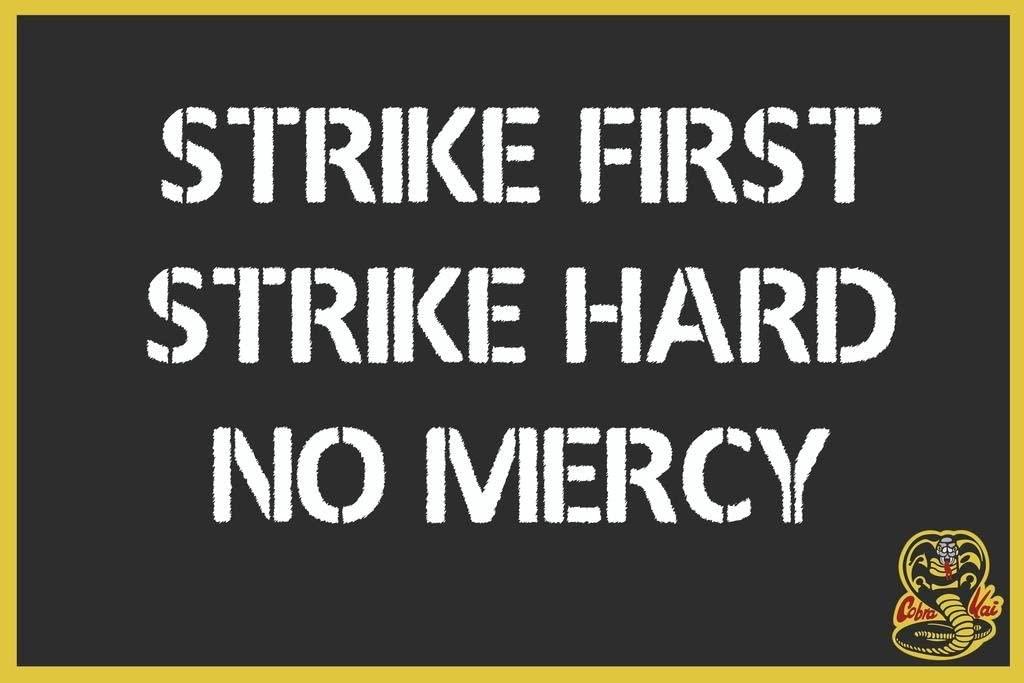My last post about the various sayings (sometimes called “rules”) attributed to BJJ patriarch Carlos Gracie, and how they were actually copied from elsewhere lead me on to thinking about the 9 rules that Wing Chun grandmaster Ip Man created, perhaps in response to the well known 10 rules of Choy Li Fut, from the previous generation.Sets of simple rules to follow help bind a style together and give the participants a sense of a shared identity. Even Cobra Kai has a short set of rules to be followed - “strike first, strike hard, no mercy”, and of course, “Cobra Kai never dies!” and “Defeat does not exist in this dojo!”. It seems that if you want to make your martial art a success then a short list of simple and easily followed rules is standard practice.
Choy Li Fut was one of the first commercial martial arts in China - in fact, when Chan Hung (1806-1875) opened his first Kwoon in 1836, it was probably the first ever place where you could actually go and buy kung fu lessons. The concept of “martial arts” as we know them today - i.e. as a commercial enterprise - was unheard of at the time, and Chan Hung was an innovator in this respect.
Chan Hung’s Choy Li Fut was a combination of older family systems like Li Gar, Choy Gar and Hung Kuen, with the word “Fut” meaning Buddah, added out of respect for his religious beliefs. Choy Li Fut is known for its big circular techniques, twisting body and agile footwork.
Chan Hung himself lived an eventful life. He was hired as a coach for local militia (the butterfly knives found in Wing Chun and Choy Li Fut are a direct ancestor of the “two short swords” used in local militia training in the 1840s), and allegedly served in the Ching army, fighting the British at the outbreak of the Opium War.
By the end of the century Choy Li Fut had become the most popular martial art in Guangdong with schools in every major county and town in the province, dominating the other styles like Wing Chun and Hung Gar. But the progress of Choy Li Fut was far from plain sailing though. For example, all martial arts schools in the area were banned for a period of 10 years after the Red Turban rebellion around 1855. Choy Li Fut declined substantially on the mainland after the Communists took over in 1949. In Hong Kong, where it could still survive it was on an equal footing with other martial arts, and no longer in a dominant position.
One of the successors to Chan Hung was Chan Ngau Sing (1864-1926), who took over the Hung Sing organisation in the 1890s when it was still a very large organisation, but in decline. Chan would have been a rough contemporary of Chan Wah Sun, teacher of the famous Ip Man, and they would possibly have mixed in the same circles.
Chan Ngau Sing managed to revive the fortunes of the Hung Sing association, I think, because he was very good at marketing and managed to make Choy Lee Fut very appealing to the working class clientele of Guangdong. It was Chan who made martial arts more respectable for the average working class man by improving its image with innovations such as a 10 point code of ethics for his members:
Ten Points
- Seek the approval of your master in all things relative to the school.
- Practice hard daily.
- Fight to win (but do not fight by choice).
- Be moderate in sexual behavior.
- Eat healthily.
- Develop strength through endurance (to build a foundation and the ability to jump).
- Never back down from an enemy.
- Practice breathing exercises.
- Make the sounds (“Yik” for punches, “Wah” for tiger claws, “Tik” for kicks).
- Through practice you cannot be bullied.
They’re quite bullish. Ben Judkins did an interesting comparison between these 10 rules of conduct from Choy Li Fut and the much more moderate 9 rules that Ip Man created for Wing Chun, much later on, which read like an evolution of Choy Li Fut’s 10 points.
Wing Chun’s 9 points:
- Discipline yourself to the Rules: Keep Sacred the Martial Morality.
- Understand Propriety and Righteousness: Love your Country and Respect Your Parents.
- Love Your Classmates: Enjoy Working Together as a Group
- Control Your Desire: Stay Healthy
- Work Hard and Keep Practicing: Never Let the Skill Leave Your Body
- Learn How to Keep the Energy: Quit Inciting a Fighting Attitude.
- Always Deal with World Matters with a Kind Attitude that is Calm and Gentle.
- Help the Elderly and the Children: Use the Martial Mind to Achieve “Yan”
- Follow the Former Eight Rules: Hold to the Ancestors’ Rules Sincerely.
While some of the rules seem identical to the Choy Li Fut 10, it’s interesting to note how bold statements like “Never back down” have evolved to become “Quit Inciting a Fighting Attitude”.
By the time of the (admitedly fictional) Cobra Kai dojo of the 1980s even these 9 rules were too long and complicatd. The marketing process had been refined down to just 3 simple rules.
Martial arts, if they are to survive, must change with the times. I feel that Chan Ngau Sing, Yip Man, Carlos Gracie and Sensei Johnny Lawrence of Cobra Kai, knew this very well.

For more information about the history of Chinese martial arts in the Pearl River Delta in the 19th century, see Ben Judkins book The Creation of Wing Chun.


